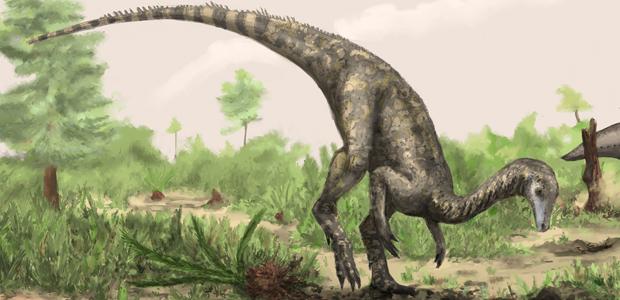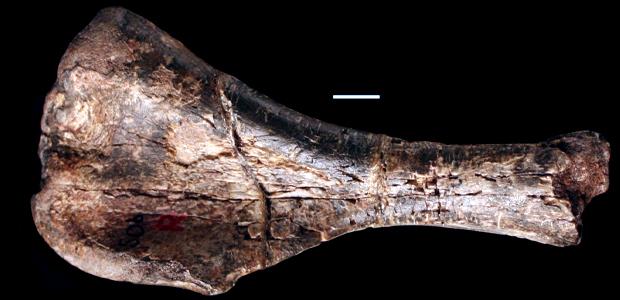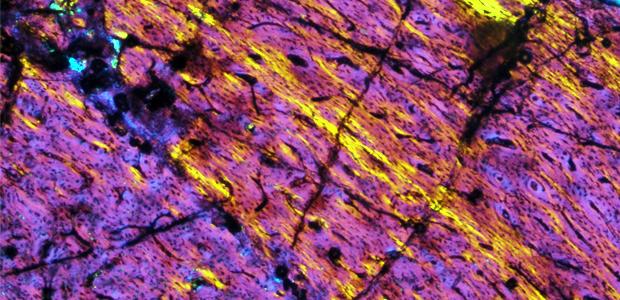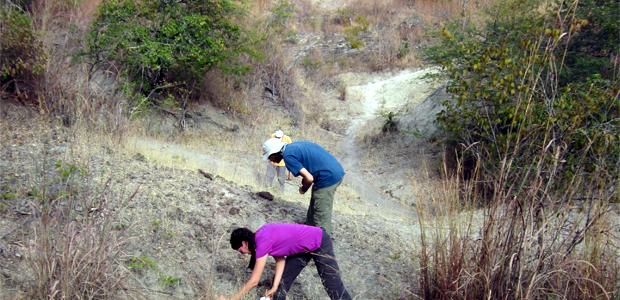A prehistoric riverbed has belched the fossil remains of a new creature that an international team of researchers say, shows dinosaurs may have started walking into the fossil record, as much as 15 million years earlier than previously thought.
A prehistoric riverbed in Tanzania has belched a new fossil that a team of British and American researchers said shows dinosaurs may have started walking into the fossil record as much as 15 million years earlier than previously thought.
“Every character it has is consistent with it being an early dinosaur,” Sterling Nesbitt, study co-author and postdoctoral researcher at the University of Washington, told SciFare.com. “But there really isn’t a smoking gun character to tell us if it’s actually a dinosaur or the closest relative so far.”
What’s certain is that features of its upper arm bone are almost exclusive to dinosaurs found in the Late Triassic – the other six bones that make up its spine, tell a cool story too – so finding them in the Middle Triassic, at least 10 million years earlier, is exciting.
The shape of the end that connects it to the shoulder provided the first story– it’s technically called a humerus. To the untrained eye, it fans out but, to researchers, it’s a deltopectoral crest and it’s more enlarged than any of its dinosaur relatives, so far.
They say it provided much needed real estate for muscles that would allow Nyasasaurus to use its front limbs like arms – a fossil feature that doesn’t start showing up in their family tree until roughly 230 million years ago.
“All dinosaurs have this elongated crest on the humerus,” Nesbitt said. It also means that Nyasasaurus likely walked on two legs, while the closest relatives to dinosaurs, still walked on four.
Using a technique known as histology – one that yields some beautifully colorful pictures – the researchers say they also found patterns that show Nyasasaurus grew like an early dinosaur.
The technique’s cool because it essentially allows researchers to study dinosaur bones like tree rings. Each of its components are stained a different colour and patterns that are normally hidden, emerge.
In this case, it’s how fast Nyasasaurus grew. Researchers know that as growth rate increases, the bone’s pattern gets noticeably less organized.
“All dinosaurs and their closest relatives grew pretty quickly but, dinosaurs grew a little bit more quickly,” Nesbitt said. When they analyzed the Nyasasaurus sample, researchers said the growth rate was closer to dinosaurs than to their closest relatives.
With the six vertebrae, the researchers were able to tell a story of what Nyasasaurus might have looked like.
“You don’t see major [morphological] gaps in early dinosaur evolution anymore,” Nesbitt said. “It’s a gradual acquisition of dinosaur-like characters that make it a dinosaur.”
So, along with the new information about the humerus, they compared the shape and size of the Nyasasaurus bones to those already documented in the fossil record from its closest relatives.
The researchers said it had a tail that was about five feet long and its entire length could have been as much as ten feet – which is roughly three metres.
But, the plant-eating creature only stood about a metre tall at the hip and weighed about 135 pounds.
The creature had an abnormally long neck though – one that admittedly surprised Nesbitt.
“We can look at how long the vertebrae are and we know that almost all reptiles have about ten cervical vertebrae,” he said.
It all might be complete enough for them to create the cool portrait but, the find might also open up an epic new chapter in the fossil record.
“Maybe [dinosaurs] didn’t explode into these forms as soon as they evolved,” Nesbitt said. “Maybe we’re just missing the fossil record for 10 million years of these early dinosaurs.”
Nyasasaurus happens to show up in the fossil record at the same time as the closest ancestor to dinosaurs, the archosaurs.
Fast forward to the beginning of the Late Triassic and the earliest known dinosaurs like Eoraptor, also show up at the same time as their closest relatives – the dinosaurs we’ve immortalized in pop culture.
“More importantly, they’ve differentiated into their three major lineages,” Nesbitt said. “As soon as they show up in the fossil record they’re already somewhat diverse.”
It’s a challenge that paleontologists faced when describing the evolution of birds.
“It wasn’t the invention of bird characters all at once – they came across gradually through a lot of therapod evolution,” Nesbitt said. “The same thing’s true of Dinosauria, almost all the characters that were once thought to be distinct dinosaur characters, are now found in their closest relatives.”
They won’t be able to place the creature firmly into its family tree until they find a complete skeleton and the grasses that cover the ancient riverbed hint at one the challenges researchers face when scouring the Manda Formation.
The continents were still glued together as Pangaea then too – which is why the earliest dinosaurs are found at the Ischigaulausto Formation in South America and the earliest relatives to dinosaurs are found in Africa.
For now, they’re getting ready to describe two new Archosaur fossils that were discovered during their last visit – discoveries that suggest the Manda Beds may eventually yield a complete Nyasasaurus too.
The research was published in the journal, Biology Letters.
 Science Fare Media Science News – Upgraded
Science Fare Media Science News – Upgraded





